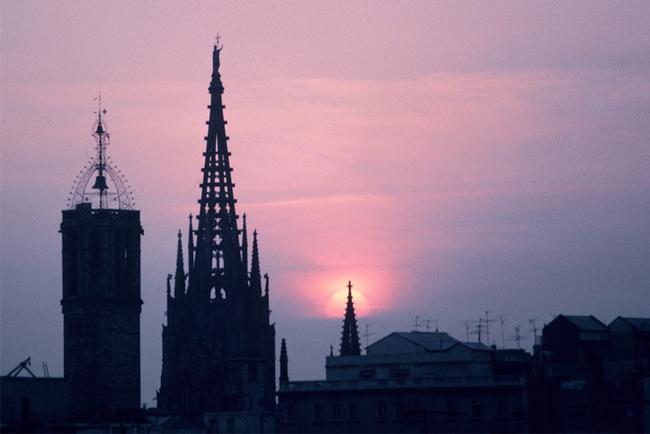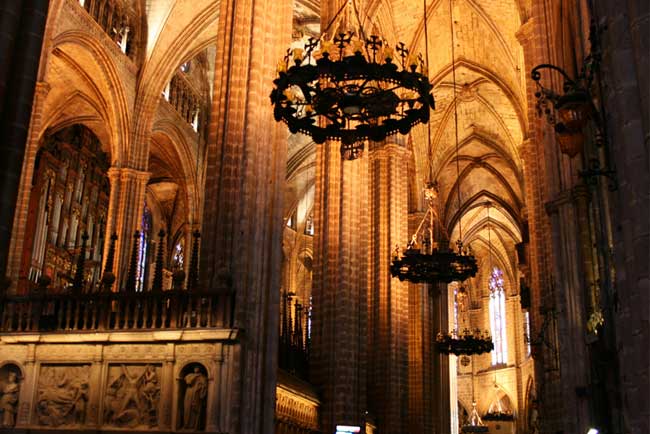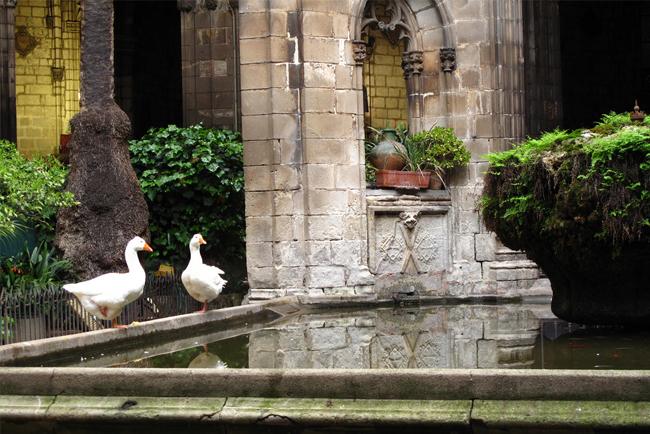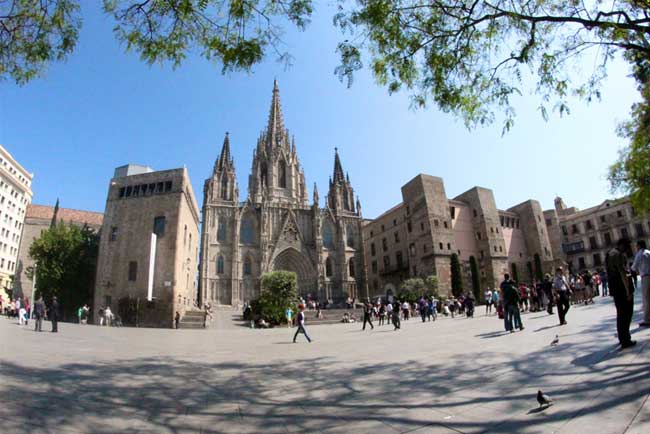Online bookings
24 hours a day
0044 (0) 20 3239 1595
English Phone
Mon-Fri: 8-16:00 GMT
Customer Service
Barcelona is a city with a wealth of churches: in addition to Gaudi's superb Sagrada Familia (the Holy Family), as you stroll along the streets in the city center, you'll come across various masterpieces of Gothic architecture on every corner with the vast Cathedral being the most emblematic.

Barcelona's Cathedral is dedicated to the Holy Cross and St. Eulalia, the historic former patron saint of the city whose feast day is still celebrated on 12th February with one of the most beautiful fiestas that you can enjoy in the Catalan capital. This wonderful church which was built in the Gothic style, is situated in the heart of the Ciutat Vella (the Old Town) and represents the most lively area of the Gothic Neighborhood. Every year, in the square in which it is held, the Placita de la Seu, a variety of fairs are celebrated in which you can buy everything from wine to books and Christmas items. When there aren't any stalls up, talented street artists put on a show in front of the Cathedral of Barcelona which makes for a happy and lively atmosphere. In order to get to the Cathedral, you can hop on the Yellow Line L4 on the Metro and get off at the station called Jaume I, or you can reach it on foot from the Plaza Catalunya by walking along the Avenida del Portal de l’Angel. You can also get to the Cathedral along the Via Layetana which borders it and marks the end of the Born neighborhood.
Although it may seem like an old church that is "one unit," Barcelona's Cathedral is actually the result of building work in four different places of worship which have marked the religious history of the city. Before Christianity, during the time of the Roman Empire, in the spot where the Cathedral is now located, there was actually a temple that was dedicated to Jupiter. With the arrival of Constantine in 313 AD, a Christian church was erected in its place and was dedicated to the young woman called Eulalia who, ten years previously, had been persecuted for her Christian faith. With the arrival of the Visigoths, the city of Barcelona very quickly succumbed to seeing the light of the Christian faith: St. Eulalia (who later became the city's patron saint) and St. Cucufate were martyred during the persecution by Diocletian which is testament to the fact that there were Christians in Barcelona since the 3rd Century. Unfortunately, there isn't much definitive information about the ecclesiastical organization of the diocese of Barcelona until 323 AD. The documents that were available suggest that in those times, Barcelona already had an episcopal temple or Cathedral which, later on, was used by various well-known bishops who were part of the city's history. According to ancient documents, in 599 AD, the Cathedral of Barcelona was dedicated to the Holy Cross.
The most recent excavations have revealed the structure of a building with three naves, separated by two series of white marble columns which, without doubt, belong to the Paleo-Christian Basilica of Barcelona which was built in the fourth century and was run by a variety of bishops during seven long centuries. In 877 AD, this basilica solemnly welcomed the relics of Santa Eulalia into one of its chapels. These had been hidden until the Moors invaded the Iberian Peninsula in 711 and had been taken care of during all this time in the nearby church of Santa María del Mar. This primitive Cathedral was, in fact, profoundly damaged by the Moors but it remained standing until 1046, the year in which the count of Barcelona, Ramón Berenguer, who was known as the Elder, and his wife Almodis, together with one of the bishops, began to build a new cathedral which was known as the Romanesque Cathedral. This second cathedral was consecrated on the 18th November 1058 by Archbishop Wilfred of Narbonne.

The current Cathedral of Barcelona was built on the remains of the Paleo-Christian basilica and the Romanesque Cathedral: the result is this wonderful building in the Gothic style which we see today. Work began on the 1st May 1298 and was finished in the middle of the XV century. You can see the three representative stages of this 150 years worth of building work: in the first stage, the planning of the entire building was completed and the building of the apse and the three chapels was then undertaken. The presbytery and the crypt followed. After that, the three naves were lengthened with their respective side chapels towards the choir. And to finish, the construction of the basilica continued to include the facade which was closed off by a simple wall. This took place in 1617 and the cloister was finished in 1448. At the end of the 19th century, an industrialist from Barcelona completed the work on the facade and its two lateral towers and his work was finally finished thanks to his children in 1913.
The Cathedral's Cloister is one of the most beloved attractions of the church: it attracts the attention of hundreds of tourists every day as they walk along the Carrer Bisbe and are then astonished by the presence of some unexpected guests: beautiful white geese. Unusual, right? There seem to be 13 geese, the same number as the age of St. Eulalia when she was martyred. (Try and count them)! In addition to this, every year during the feast of Corpus Christi, the tradition known as “ou com balla”, (the dancing egg), takes place in the cloister of the Cathedral. It involves dressing up and making an egg dance in a jet of water from the small fountain that's situated in the middle of the cloister and is decorated for the occasion with red and yellow flowers (the colors of Catalonia). You can visit the Cathedral cloister from Monday to Saturday from 08:30 until 12:30 in the morning and from 17:15 until 19:00 in the evenings. On Sundays and public holidays, the opening time in the morning is brought forward by half an hour.

You can visit the Cathedral free of charge between 08:00 and 12:45 and from 17:45 to 19:00 (on Saturdays and Sundays this changes from 17:15 to 20:00) whilst at other times, it is necessary to pay for entry. For further information regarding entry to the Cathedral, you can visit its official website: catedral.org. Barcellona.shop can also propose a visit to the interior of this church with a tour that is designed for those who want to visit Barcelona in two days for free. You can also request a private guide on this web page who will be at your disposal to accompany you on your visit and will explain all the intimate secrets of this place. For example, did you know that there is a terrace that can be accessed from inside the church?
In addition to the spectacle of “ou com balla” (the dancing egg) which is celebrated on the feast of Corpus Christi, in other words 60 days after Easter, two other important dates on the list of celebrations at this place of worship are worth noting: that of Santa Lucía, on the 13th December and Santa Rita which is celebrated on the 22nd May. Devotees of the blind martyr invoke her protection for their sight and head towards the Cathedral's Romanesque chapel to venerate her relics. There is also the vigil of the birthday festivities in the Plaza de la Seu which takes place during the great Feast day of Santa Lucia where it is possible to buy typical Christmas products and a range of objects hand-crafted by local carpenters. However, in spring, on the feast day of Santa Rita, a different chapel in the church is used and roses are blessed after the 11 o'clock Mass.

On Sundays and on feast days, 6 Masses are celebrated: four are in Catalan and two are in Spanish (at 12 o'clock and 6 pm). These Masses are celebrated at the high altar whereas on Saturdays and on days prior to a feast day, mass is celebrated in the chapel of the Blessed Sacrament (2 in Catalan and 1 in Spanish at 12:00) as well as at the main altar (at 18:00 in Spanish and at 19:00 in Catalan). On weekdays, 4 Masses are celebrated daily in the chapel of the Blessed Sacrament: 3 in Catalan and 1 in Spanish at 12:00. Do you want to find out more about why two languages are spoken in Barcelona and what the differences are, which could be useful? Then you can read the articles entitled the history of Catalonia and about the Spanish language.
If you visit the Basilica of Santa María del Mar first and then the Cathedral of Barcelona, you will immediately notice an astonishing difference: the first church has an open interior whereas the second church contains a "reserved area." This is the area which in the past, was destined for the use of the nobility - who distinguished themselves as separate from the commoners. The Catedral del Mar, on the other hand, was built "by the people for the people." You will also find another curious detail inside the Cathedral of Barcelona which you should look out for: the crucifix. This is a model which dates back to the fifteenth century and was allegedly hoisted onto the ship of John of Austria as his standard during the Battle of Lepanto against the Turks in 1571. It gives the appearance that in the middle of the crucifix, the figure of the crucified Christ was moved in order to avoid a cannonball. This explains the reason why visitors notice the figure of Christ with an unusual inclination of the chest.
My comments